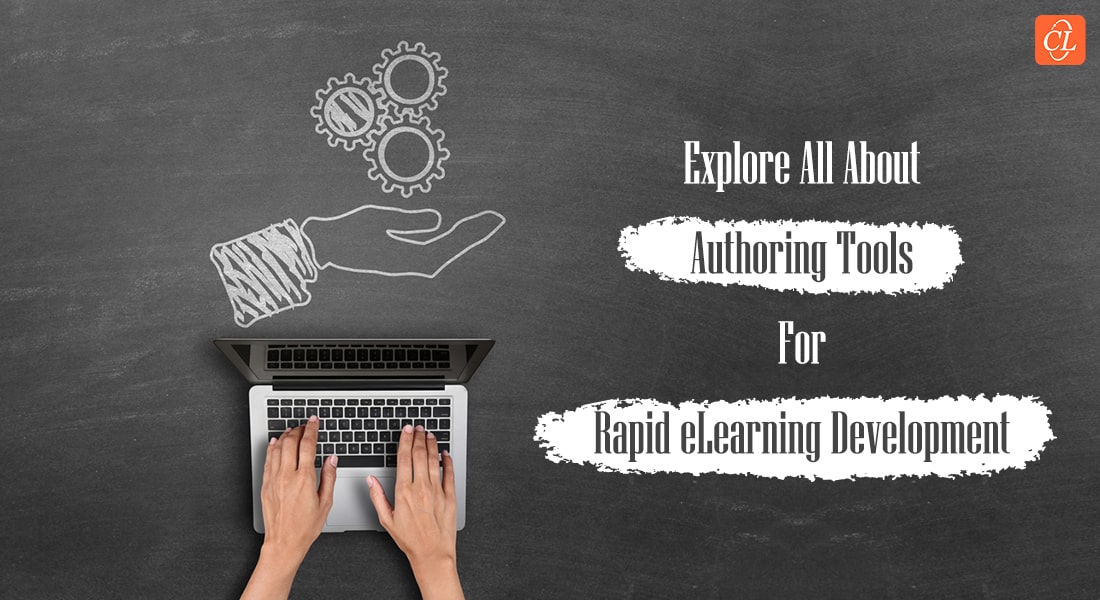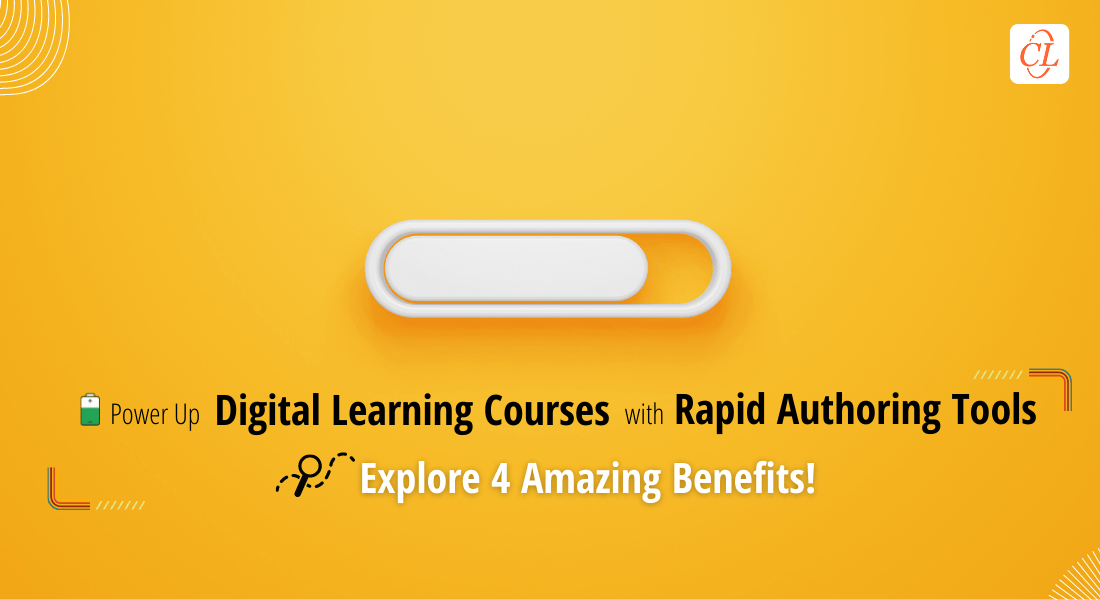Authoring Tools: The Key to ‘Truly Rapid’ eLearning Development

Are you worried about how well your eLearning courses are working? Rapid eLearning is the solution to all your training problems, whether it be converting your legacy courses to HTML5, eLearning translations, or classroom to eLearning. They ensure your workforce has an engaging learning experience while also helping to improve your training ROI. And guess what drives rapid eLearning’s success? You’re correct, of course! Certainly, authoring tools!
Wondering How Authoring Tools Help in Rapid eLearning Development?
Here are the Top 4 Ways it Helps:
- Rapid Development of eLearning Courses
- Translations for Multilingual eLearning
- Quick and Easy Conversion of Legacy Courses to HTML5
- Reviews of Online Courses That Are Quick and Easy
The Superhero of Rapid eLearning Development: Authoring Tools
As you are already aware, an authoring tool is a software program that has pre-programmed capabilities that aid in creating interactive multimedia material.
Rapid authoring tools, which are brimming with intriguing features and templates to construct efficient and engaging courses quickly, can become your newest best friend, assisting you and your crew of developers in creating and releasing courses that will delight your learners.
Rebuilding or redesigning your eLearning courses is a straightforward process thanks to authoring tools. Each tool has a unique collection of capabilities that are tailored to the needs of various eLearning course types. To make your eLearning courses more fascinating and engaging, they could also assist you in designing templates, creating assessments, and including interactivities.
Each authoring tool has its unique characteristics, so not all are made equal. They may also be divided into three categories: cloud-based, desktop-based, and PowerPoint-based, depending on how they function.
Different Types of Authoring Tools
1. PowerPoint-Based Authoring Tools
These authoring programs function as Microsoft PowerPoint add-ins. There is almost no learning curve, and they are quite simple to operate. With just a few simple interactivities, you can create straightforward digital learning resources.
Examples include Articulate Studio and Adobe Presenter.
2. Desktop-Based Authoring Tools
Desktop-based tools for eLearning development and design are most often utilized. They must be installed on a separate system, hence their name. They include a wide range of capabilities and are perfect for creating courses with a high level of customization and interaction. They require more training than authoring tools that use PowerPoint, though.
Examples include iSpring Suite Max, Lectora Inspire, Articulate 360, and Adobe Captivate.
3. Cloud-Based Authoring Tools
Online authoring tools that can be used on many systems without needing to be installed are called cloud-based authoring tools. They often come with a subscription and are provided as Software as a Service (SaaS). They provide concurrent use of the tool by several users through collaborative authoring.
Lectora Online, Articulate Rise, and Easygenerator are some examples.
In the fast-paced business environment of today, businesses need an agile training solution that can be tailored to their shifting training requirements and reduce the time and expense of eLearning creation. And the solutions you’ve been looking for are rapid authoring tools with amazing capabilities! Let’s go through everything they have to offer.
What Role Can Authoring Tools Play in Bringing Life to Your eLearning Courses?
1. Rapid Development of eLearning Courses
The current trend is toward eLearning. And transferring your classroom training materials to online learning without sacrificing learner involvement is the initial move in that direction. Authoring tools can help create courses that will unquestionably keep learners interested.
However, you must prepare your material before you begin the real design and creation of courses utilizing authoring tools. This entails conducting a thorough examination of all the information that is currently accessible, completing any information gaps, establishing performance-based learning goals, and developing an effective instructional method.
After completing all of that, you may use authoring tools to create and build eLearning courses. quickly. Let’s explore how.
- To develop standard displays, you may utilize the multimedia materials collection (which includes photos, music, video clips, and built-in designs)
- To make your courses more interesting, you may utilize built-in interactivities like animations, pop-ups, animations, simulations, and gamification.
Check out this Detailed Guide on the Basics of Instructional Design.
2. Translations for Multilingual eLearning
Since international personnel may not speak English as their first language, it is necessary to convert your online courses into various languages if you want to provide uniform training throughout the business and make training efficient and interesting for all your personnel. Authoring tools also provide simple translations.
Courses may be created using authoring tools in a variety of languages. They include translation software that enables exporting an eLearning course’s material in Rich Text Format (RTF). It is possible to translate this content and import the converted version into the course. Language switching is made possible during the course via the swappable interface offered by authoring tools like Lectora.
3. Quick and Easy Conversion of Legacy Courses to HTML5
If you’ve been utilizing eLearning for workforce training for a while, your library probably contains a ton of outdated FLASH courses. Additionally, your courses—which you toiled so laboriously to create—are now useless to you since FLASH has become obsolete. Similar legacy courses that were created using previous versions of authoring tools may have the same issue. Or programs that don’t work on mobile platforms or have out-of-date material.
What will you do with your legacy courses, then?
By converting them to HTML5 output, you may keep using your Flash-based or other older courses. The courses may be republished in the authoring tool newer versions like Adobe Captivate 2019, and Articulate Storyline 360. You may also alter and update the material in your out-of-date legacy courses. Additionally, by republishing your outdated legacy programs, you may make them mobile-friendly.
With the use of rapid authoring tools’ built-in interactivities, you may duplicate the interactivities of your legacy courses and republish them in HTML5 format. Without having to deal with the burden of intricate programming, you may create courses that incorporate branching scenarios and gamification using rapid authoring tools.
4. Reviews of Online Courses That Are Quick and Easy
At various stages of their production, eLearning courses must be evaluated. Multiple assessors, however, might make the review process time-consuming. It becomes difficult to navigate through divergent viewpoints and put input into practice.
Due to the fact that most of them provide online review applications, rapid authoring tools might assist you in resolving your issue and simplify the entire process. Some examples of such tools are Articulate Storyline 360, Elucidat and Adobe Captivate.
- Rather than delivering storyboards (as course files and PPT decks), you may just provide all of the reviewers a review URL so they can all read the resources at once.
- The reviewers can enter information through comments, which saves a substantial amount of time. The feedback does not require its document, which is unnecessary. Since reviewers may access all the comments from all reviewers, the likelihood of contradictory or redundant criticism is also reduced.
- Because it is simplified and enables developers to keep a record of solved and unsolved remarks, this also makes it far simpler for them to incorporate the feedback.
Parting Thoughts
Authoring tools must be understood before beginning the process of eLearning development and design. I hope this blog post has clarified any queries you had regarding authoring tools and provided some information on how they might aid in creating excellent courses.
Do you still have questions about how to assess your alternatives and choose the best authoring tool for your training courses? Don’t worry, however. Get a glimpse of “How to pick the right authoring tool” by downloading this eBook, and you’ll discover practical tips that will help you usher in a new era of innovation in learning and development.





